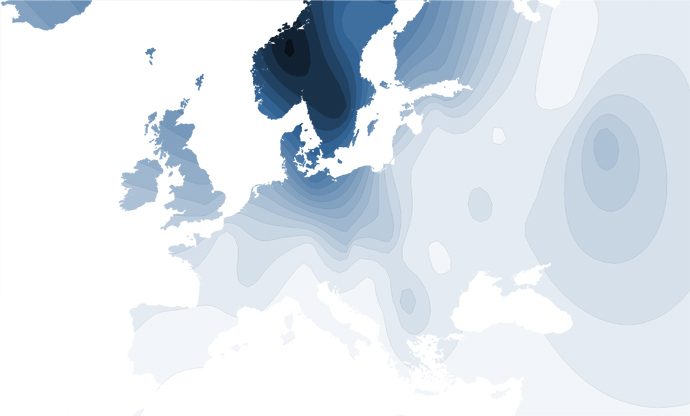| Y-chromosome Haplogroups |
In addition to your Y-chromosome STR results, we are able to accurately predict which "haplogroup" your Y-chromosome belongs to. Haplogroups can be thought of as branches of the Y-chromosome genetic tree. With its roots in Africa approx. 140,000 years ago, as time has progressed, small mutations have occurred on the Y-chromosome. When a mutation happens (called a SNP, pronounced "snip"), the tree branches so that over time and as people have migrated into different continents and regions, we see a tree-like structure with branches found in certain parts of the world.
Because particular STR patterns are seen within particular haplogroups, on most occasions we can predict which haplogroup you are in and where your Y-chromosome fits into this Y-chromosome tree. Along with the prediction, we also provide the history, background and mapped distribution of your haplogroup.
Please be aware that, whilst our comparative database uses up to date information, it may not be possible to make an accurate prediction on all occasions and sometimes no prediction can be made.
| Your Predicted Haplogroup: I1a |
The initial proliferation of the Haplogroup I (defined by the SNP marker M170) within Europe is most often associated with the flow of the mainly pan-European Gravettian technology. The mutation is estimated to be about 22-23,000 years old and possibly stemmed from descendants who arrived from the Near East about 25,000 years ago. The Gravettian was an industry of the European Upper Paleolithic known for the "Gravette Point" small pointed stone blade and also for the famous Venus figurines. Mammoth hunting was very common during this period and is about the time when minor dialectical differences of the proto-Indo-European language developed between eastern and Western Europe.
As the last ice-age began, it became necessary to move down to below the tree-line to hunt game. At its peak, the ice shelf within Europe extended down as far as southern Ireland, the middle of England and across northern Germany. Scandinavia was entirely covered. The sea-ice pack extended as far as northern Spain and tundra covered much of continental Europe. The tree-line at the height of the ice-age was as far south as Southern France, Northern Italy, north of the Balkans and across the Black Sea. Haplogroup I populations predominantly took refuge in the Balkans although there is good evidence that the Franco-Cantabrian region was a refuge for this haplogroup also.
As the ice-age ended and the fauna and flora were able to move northward again, people in Haplogroup I also migrated north.
Defined by the SNP markers P30 and M253, Haplogroup I1a has the most frequent and widespread distribution area among Haplogroup I sub-clades, most common in Scandinavia; Swedish, Norwegian and Saami populations. Evidence to support the Franco-Cantabrian theory includes a higher STR (short tandem repeat) diversity in western Europe and the I1a haplogroup being the most common of the I haplogroups in France. A possible coastal migration route exists and there appears to be a population expansion from the Scandinavian region at the start of the Holocene epoch (from 10,000 years ago). Haplogroup I1a shows a good correlation with Haplogroup I1c and also with the mtDNA Haplogroups of V and U5b.
| Distribution of Haplogroup I1a |
